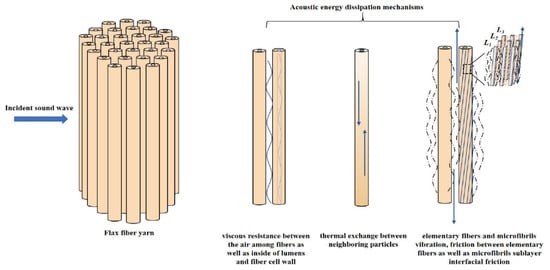Sound Absorption Characterization of Natural Materials and Sandwich Structure Composites
Abstract
:1. Introduction
2. Materials and Experiments
2.1. Materials
2.2. Fabrication
2.3. Acoustic Property Measurement
3. Results and Discussions
3.1. Sound Absorption Performance of Flax Fiber and Its Reinforced Composite
3.2. Sound Absorption Performance of Balsa Wood
3.3. Sound Absorption Performance of Sandwich Structures
4. Conclusions
Author Contributions
Funding
Acknowledgments
Conflicts of Interest
References
- Wilby, J.F. Aircraft interior noise. J. Sound Vib. 1996, 190, 545–564. [Google Scholar] [CrossRef]
- Liu, J.L.; Bao, W.; Shi, L.; Zuo, B.Q.; Gao, W.D. General regression neural network for prediction of sound absorption coefficients of sandwich structure nonwoven absorbers. Appl. Acoust. 2014, 76, 128–137. [Google Scholar] [CrossRef]
- Zheng, Z.Y.; Li, Y.; Yang, W.D. Absorption properties of natural fiber-reinforced sandwich structures based on the fabric structures. J. Reinf. Plast. Compos. 2013, 32, 1561–1568. [Google Scholar] [CrossRef]
- Petrone, G.; D’Alessandro, V.; Franco, F.; De Rosa, S. Damping evaluation on eco-friendly sandwich panels through reverberation time (RT 60) measurements. J. Vib. Control 2015, 21, 3328–3338. [Google Scholar] [CrossRef]
- Petrone, G.; D’Alessandro, V.; Franco, F.; Mace, B.; De Rosa, S. Modal characterisation of recyclable foam sandwich panels. Compos. Struct. 2014, 113, 362–368. [Google Scholar] [CrossRef]
- Sargianis, J.J.; Kim, H.I.; Andres, E.; Suhr, J. Sound and vibration damping characteristics in natural material based sandwich composites. Compos. Struct. 2013, 96, 538–544. [Google Scholar] [CrossRef]
- Fratzl, P.; Weinkamer, R. Nature’s hierarchical materials. Prog. Mater. Sci. 2007, 52, 1263–1334. [Google Scholar] [CrossRef] [Green Version]
- Charlet, K.; Jernot, J.; Eve, S. Multi-scale morphological characterisation of flax: From the stem to the fibrils. Carbohydr. Polym. 2010, 82, 54–61. [Google Scholar] [CrossRef]
- Meredith, J.; Ebsworth, R.; Coles, S.R.; Wood, B.M.; Kirwan, K. Natural fibre composite energy absorption structures. Compos. Sci. Technol. 2012, 72, 211–217. [Google Scholar] [CrossRef]
- Berardi, U.; Iannace, G. Acoustic characterization of natural fibers for sound absorption application. Build. Environ. 2015, 94, 840–852. [Google Scholar] [CrossRef]
- Duc, F.; Bourban, P.E.; Plummer, C.J.G.; Månson, J.A.E. Damping of thermoset and thermoplastic flax fibre composites. Compos. Part A-Appl. Sci. 2014, 64, 115–123. [Google Scholar] [CrossRef]
- Tang, X.; Yan, X. Acoustic energy absorption properties of fibrous materials: A review. Compos. Part A-Appl. Sci. 2017, 101, 360–380. [Google Scholar] [CrossRef]
- Prabhakaran, S.; Krishnaraj, V.; Senthil kumar, M.; Zitoune, R. Sound and vibration damping properties of flax fiber reinforced composites. Procedia Eng. 2014, 97, 573–581. [Google Scholar] [CrossRef]
- Yang, W.; Li, Y. Sound absorption performance of natural fibers and their composites. Sci. China Technol. Sci. 2012, 55, 2278–2283. [Google Scholar] [CrossRef]
- Olny, X.; Boutin, C. Acoustic wave propagation in double porosity media. J. Acoust. Soc. Am. 2003, 114, 73–89. [Google Scholar] [CrossRef] [PubMed]
- Damian, B. An introduction to core materials. Reinf. Plast. 2014, 58, 32–37. [Google Scholar]
- Borrega, M.; Ahvenainen, P.; Serimaa, R.; Gibson, L. Composition and structure of balsa (Ochroma pyramidale) wood. Wood Sci. Technol. 2015, 49, 403–420. [Google Scholar] [CrossRef]
- Borrega, M.; Gibson, L.J. Mechanics of balsa (Ochroma pyramidale) wood. Mech. Mater. 2015, 84, 75–90. [Google Scholar] [CrossRef]
- Silva, A.D.; Kyriakides, S. Compressive response and failure of balsa wood. Int. J. Solids Struct. 2007, 44, 8685–8717. [Google Scholar] [CrossRef]
- Atas, C.; Sevim, C. On the impact response of sandwich composites with cores of balsa wood and PVC foam. Compos. Struct. 2010, 93, 40–48. [Google Scholar] [CrossRef]
- Osei-Antwi, M.; Castro, M.; Vassilopoulos, A.P.; Keller, T. Fracture in complex balsa cores of fiber-reinforced polymer sandwich structures. Constr. Build. Mater. 2014, 71, 194–201. [Google Scholar] [CrossRef]
- Champoux, Y.; Allard, J. Dynamic tortuosity and bulk modulus in air-saturated porous media. J. Appl. Phys. 1991, 70, 1975–1979. [Google Scholar] [CrossRef]
- Li, Y.; Cai, S.; Huang, X. Multi-scaled enhancement of damping property for carbon fiber reinforced composites. Compos. Sci. Technol. 2017, 143, 89–97. [Google Scholar] [CrossRef]











| Materials | Fiber Density (g/cm3) | Mean Fiber Diameter (μm) | Mean Yarn Diameter (μm) | Areal Density (g/m2) | Mean Thickness (mm) | Specific Strength (MPa/g/cm3) | Specific Modulus (GPa/g/cm3) |
|---|---|---|---|---|---|---|---|
| Flax fabric | 1.5 | 15 | 200 | 213.3 | 0.2 | 1034 | 55 |
| Glass fabric | 2.55 | 11 | 100 | 207.5 | 0.1 | 980 | 30 |
| Materials | Density (kg/m3) | Porosity | Cellular Diameter (μm) | Axial Compression Modulus (MPa) | Transverse Compression Modulus (MPa) |
|---|---|---|---|---|---|
| Balsa wood | 125 | 0.920 | 35–200 | 280–320 | 30–80 |
| PET foam | 112 | 0.933 | 500–700 | 90 | 90 |
© 2018 by the authors. Licensee MDPI, Basel, Switzerland. This article is an open access article distributed under the terms and conditions of the Creative Commons Attribution (CC BY) license (http://creativecommons.org/licenses/by/4.0/).
Share and Cite
Zhang, J.; Shen, Y.; Jiang, B.; Li, Y. Sound Absorption Characterization of Natural Materials and Sandwich Structure Composites. Aerospace 2018, 5, 75. https://doi.org/10.3390/aerospace5030075
Zhang J, Shen Y, Jiang B, Li Y. Sound Absorption Characterization of Natural Materials and Sandwich Structure Composites. Aerospace. 2018; 5(3):75. https://doi.org/10.3390/aerospace5030075
Chicago/Turabian StyleZhang, Jichun, Yiou Shen, Bing Jiang, and Yan Li. 2018. "Sound Absorption Characterization of Natural Materials and Sandwich Structure Composites" Aerospace 5, no. 3: 75. https://doi.org/10.3390/aerospace5030075






